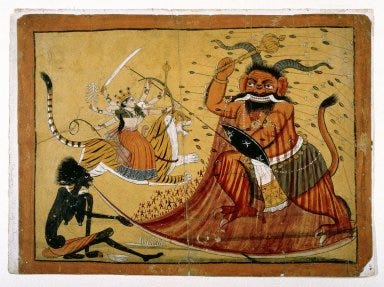Himachal Pradesh Newsletter
Resident Pahari
Lost Art Files - Himachal Pradesh - Durga, Raktabij & Kali
In this edition of Lost Art Files we bring to you some exquisite watercolor art pieces from early 19th Century Chamba, Himachal Pradesh. These high energy compositions from the Dev Bhoomi wonderfully capture the spiritual and folklore theme that is so central to the region.
Circa 1800
Durga Slaying the Buffalo Demon, Raktabij, and Kali Lapping up the Demon's Blood, Page from a Markandeya Purana Series
Medium: Opaque watercolor on paperPeriod: 1800-1825Region: Himachal Pradesh, India
The Folklore
The combined episodes of Durga's attack on the demon and Kali's lapping up his blood are here presented in one highly energized composition.
A great orange-red monster with a human body, bird's claws, buffalo horns, white tusks, and a ferocious expression, is represented at the right. The multi-armed crowned goddess Durga, astride her tiger vehicle, pierces the demon and attacks with her numerous weapons, while the black goddess Kali extends her long tongue to lap up the blood shed by the demon before it touches the ground and coagulates into new asuras (demons).
Some of the blood is transformed into numerous tiny Raktabij demons, emerging from the bloodbath who continue the battle. The violent scenes of bloody battle express the dynamic energy of the Goddess. These two episodes are related in the Devi Mahatmya text of the Markandeya Purana, in which the Goddess destroys various forms of demons, but multiple episodes incorporated in the same miniature is unusual.
The Bhayanaka rasa, or the terrible sentiment, is predominant in this scene. Depiction of Devi in her frightening form of Kali, engaged in devouring up the blood drops and tiny demons emerging from them, successfully conveys the sentiment here.

Durga Slaying the Buffalo Demon, Folio from Devi mahatmya (Glory of the Goddess)
Medium: Drawing, Ink and opaque watercolor on paperPeriod:Early 1800sRegion:Chamba - Himachal Pradesh, India
The Art
These depictions from the hills are attributed to Chamba, which was noted for a predominantly red and yellow palette and produced many illustrated Devi Mahatmya manuscripts.
One may compare these stylistic characteristics with the more refined versions of this subject in the Devi Mahatmya in Guler, c. 1740-1781 (Aijazuddin 1977: 48). Rather large and very coarse miniature painting, of Durga slaying the demon Mahisa (the asura Mahisa) with a flock of arrows, an illustration from the Markandeya Purana, a collection of mythological legends.
The asura, a huge orange red monster with a human body, birds claws, an animal's white tusks, and a ferocious expression, is represented as rising from the purple emanation coming from the mouth of a demon.
This demon, a gaunt female nude save for a dhoti, and with straight hair flying out behind, sits in one corner exhaling this emanation. The asura has a short dhoti and a white sash (kamarband) with yellow flower ends. Bells hang from the sides of the scarf around the waist. He also has armlets (bhuja-band), necklaces (mala) and bracelets (kankana).
Close to the edge of the emanation are quantities of tiny asuras, colored the same as the emanation. The devi, astride a tiger, has eight arms. Two are used in shooting the crescent pointed arrow at the asura. The others hold a mace, a spear (sakti), a feather, a sword, a noose (pasa) and a conch (sankha). She has a full red skirt (ghagara) with a blue edge, a purple sash, a short green coli, a pointed crown (mukuta) and a quiver of arrows. She wears necklaces, earrings, armlets and bracelets and has her finger and toe nails dyed henna (mihamda).
The background is yellow, save for a few streaks of green to represent the ground. On this are a white bowl and a white feather like the one the Devi is holding. The painting has a red border and is mounted on a slightly larger sheet of paper.